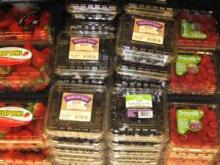Here’s a somewhat new twist to the saying, “You are what you eat.” The latest trend in anti-wrinkle efforts is “nutricosmetics,” combining cosmeceutical and nutraceutical products. In other words, using both topical and oral agents to make skin look younger than it might otherwise.
That’s the prediction of Dr. Zoe D. Draelos, a consulting professor at Duke University, who spoke at the SDEF Women’s and Pediatric Dermatology Seminar. First the buzz was about antioxidants. Next you’ll be seeing the glycation inhibitor carnosine touted in foods and products, followed in a few years by other glycation inhibitors.
Why? Because there are only three ways known to limit the effects of aging on skin: caloric restriction; preventing oxidative damage, and preventing or reversing advanced glycation end productions, she said.
It makes sense that eating a healthier diet will give you a better chance of looking younger and healthier than a poor diet will, but nutricosmetics takes this to another level, with companies in pursuit of supplements, topical agents, and other products that may deliver more of the good stuff than you can get from food alone. Dr. Draelos has received consulting and research funds from 14 different companies.
Cosmetic dermatology started moving in this direction with topical and oral antioxidants. Carotenoids (vitamin A) are found in red, orange and yellow fruits and vegetables. Think of tomatoes, which contain the antioxidant carotenoid lycopene, which inspired lycopene supplement products. Topical anti-wrinkle products may contain the synthetic carotenoids retinol, retinaldehyde or retinyl propionate. The polyphenols in green tea also are antioxidants.
Then, there’s resveratrol, a substance that modulates the activity of sirtuins, which are thought to be responsible for some of the mechanisms of aging on a mitochondrial level. French red wines are high in resveratrol, which also has been added to moisturizers to function as an antioxidant. Too much resveratrol can be bad for you, rodent studies suggest, and it’s expensive, Dr. Draelos said. Products are more likely to say that ingredients include the plant Japanese Knotweed, which contains some resveratrol.
Caloric restriction isn’t really a viable option for skin care, so the nutricosmetic industry is looking at “caloric restriction mimetics” such as anthocyanins, which are antioxidants. That’s why newer supplements will contain anthocyanins, which are found in high concentrations in wild raspberries, blackberries, and blueberries. Blueberry extract also may be a glycation inhibitor.
“Berries are going to be everywhere,” Dr. Draelos predicted. Interestingly, it’s the wild, stressed berries and the stressed grapes grown in colder areas like France that contain more of these ingredients than, say, wines from California’s milder climate or farmed berries.
Carnosine, the newest ingredient in skin care products, also seems to prevent glycation, possibly providing anti-aging benefits on the level of gene regulation.
Because these components are not drugs, the products don’t need to be tested and approved by the Food and Drug Administration, so there’s precious little science to back up anti-aging claims. Much of the marketing is based on theories of how the ingredients might help one’s skin.
An unpublished double-blind, placebo-controlled study by Dr. Draelos and her associates provides some support for oral lycopene supplements, a popular nutricosmetic product. They shined a standardized amount of simulated sunlight on the relatively pristine buttock skin of volunteers, took a punch biopsy, and counted the number of sunburned cells. Then subjects took lycopene supplements twice a day for 12 weeks before repeating the sunburn test on a different part of the buttocks. Fewer cells ended up sunburned after taking lycopene. A lower burned cell count means less oxidative damage.
Not all research is so nice. A study by other investigators of mice who were fed vitamins C and E plus extracts of green tea and blueberry tested the effects on tissue by pulling on the mice tails until the tendons snapped. To their credit, audience members at the seminar groaned when they heard this.
Someone asked Dr. Draelos what she consumes to combat aging. Because she’s vitamin D deficient, she takes vitamin D supplements, she said. She added that she likes to get her antioxidants in the form of omega-3 and omega-6 fatty acids, such as in flax seed oil and fish oil. Moderation is the key, she said. “Eat something of every color every day. Take a multivitamin. Don’t eat just blueberries, eat something of everything,” and take supplements if you’re deficient in something, she advised.
If you’re going to drink green tea, eat berries or tomatoes, or buy some French wine to combat wrinkles, or take supplements based on their ingredients, no one knows how much to eat or drink for this purpose, she added. Dr. Joseph F. Fowler, Jr., who spoke after Dr. Draelos, summed it up this way: “Actually, if you drink enough red wine, you won’t care.”



